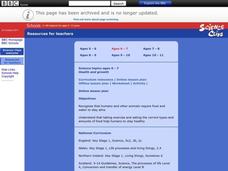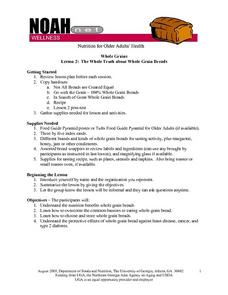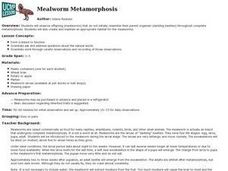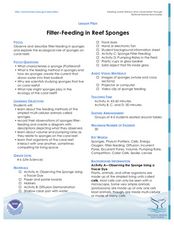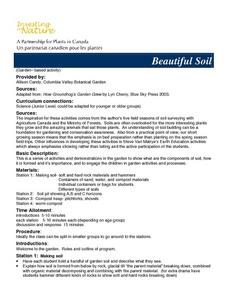Curated OER
My Favorite Breakfast Foods
First graders consider the importance eating breakfast. In this breakfast foods lesson, 1st graders plan meals, examine a variety of breakfast options, and discuss the food groups. Students taste a variety of foods. Extension activities...
Curated OER
Paragraph Writing
Third graders receive Gummi hamburgers. They discuss parts and structure of a (real) hamburger. Students dissect the gummi hamburger and rearrange the pieces. Students discuss the problems that would be caused by this with a real...
Curated OER
Korean Table Manners
Students eat a Korean meal with proper table manners. They compare American table manners to Korean with at least 3 similarities and 3 differences. They write a brief essay and describe, list and demonstrate the proper Korean...
Curated OER
Swimming With the Crabs
In this expository writing worksheet, students read an article about crabs and a graphic organizer with crab facts. Students fill in a graphic organizer, including their specific topic about crabs and details to support their topic.
Curated OER
Health and growth
Students examine ways for people to stay healthy, such as exercising and eating right.
Curated OER
Culture of China
Second graders explore the oral language of the Chinese, retell folk tales, and eat with chopsticks. They view a slide show of China to examine what life is like in China. They memorize three Chineses phrases and note three differences...
Curated OER
The Whole Trut about Whole Grain Breads
Students comprehend the nutrition benefits whole grain breads. They explore how to overcome the common barriers to eating whole grain bread. Students investigate how to choose and store whole grain breads. They comprehend the...
Curated OER
The Frog and the Ol' Black Fly
Students explore frogs. In this cross curriculum literacy and frogs lesson plan, students predict the plot and then listen to the book The Wide-Mouthed Frog by Keith Faulkner. Students define "predator" and identify foods a frog...
Curated OER
Bird Beaks and Feet
In this bird adaptations worksheet, students look at different bird pictures and determine what the bird eats and where it lives by looking at its beak and feet. Students complete a graphic organizer and 5 short answer questions.
Curated OER
Worm Composting
Second graders discuss worm composting. In this decomposition lesson, 2nd graders look at the anatomy of the worm and how it eats food. They have their own worm bin and review what foods can and can not be given to the worms for...
Curated OER
Mealworm Metamorphosis
Students observe offspring (mealworms) that do not initially resemble their parent organism (darkling beetles) throughout complete metamorphosis. They also create and maintain an appropriate habitat for the mealworms.
Curated OER
When in Rome...
Students discuss Roman social classes and create a graphic organizer illustrating each social class and its characteristics. They dress in costumes representative of their social classes as part of a Rome Day experience.
Curated OER
Habitats
Students complete food chains for organisms in three environments. They use copies of the Habitat worksheet. Students review the food chain terms with the teacher. They research related food chains, and interlink these to form a food...
Curated OER
Structural and Behavioral Adaptations
Students participate in a role playing lab that allows students to experience how different beak adaptations play a role in the type of food the animal can eat, therefore playing a role in the survival of the species.
Curated OER
Habitats and Adaptations
Students research and describe the habitat and adaptations of a reef animal. After the student is assigned a habitat, they design and draw a cresture adapted to eat each food and to live in each habitat.
Curated OER
From Eggs to Frogs
Third graders receive a small container of tapioca pudding, they are to pretend that it is frog eggs. The students pretend they are birds who see the eggs, and eat some of them. They discuss what would happen if these were really frog...
Curated OER
THE PEANUT WIZARD
Students read information about George Washington Carver and outline the information. They are given peanuts in the shell, students examine them and eat them. Students discuss the following questions: Why did George Washington Carver...
Curated OER
Alternative Practices of Agriculture
In this agriculture activity, students read the pages related to the discovery and practice of alternative ways of producing new crops. Then the graphic organizer is filled out for each idea.
Curated OER
Bird Buffet
Fifth graders investigate how birds use their beaks. For this agriculture lesson, 5th graders use tools to simulate how birds gather food with their beaks. They then draw conclusions about certain types of beaks and what types of food a...
Curated OER
Filter Feeding in Reef Sponges
Learners investigate the role of sponges in our oceans. In this biology lesson, students create a diagram visualizing how sponges bring food into their bodies through a filtering process. Learners discuss the connections...
Curated OER
Lesson 1: Identifying Information
Factual books about animals are great for sparking interest in non-fiction text. Little ones will love learning about the foods animals eat as they practice identifying facts in a text. They chart the information they've learned by...
Curated OER
Beautiful Soil
Students discover what are the components of soil. They examine how it is formed and it's importance. They engage in garden activities and processes. They hold a handful of garden soil and describe what they see. They take a...
Curated OER
Is it Alive?
Students watch a demonstration using Duco glue and water and try to determine if the "monster" shown is alive. After the demonstration, they discuss what characteristics make an organism "alive". They participate in a card sorting...
Curated OER
Gardens Throughout the World
Fourth graders study various aspects of gardens. In this garden lesson plan, 4th graders discover the location of famous gardens on a map. Students research historic gardens.




